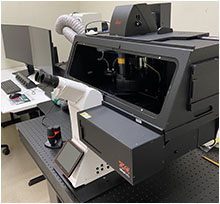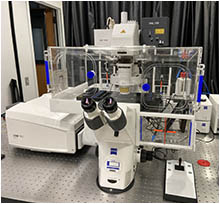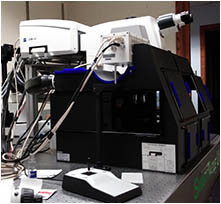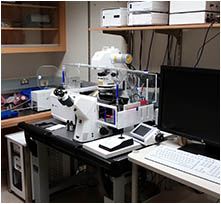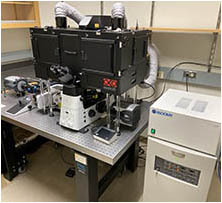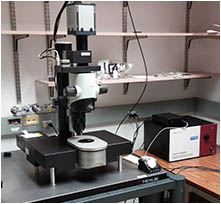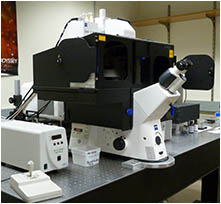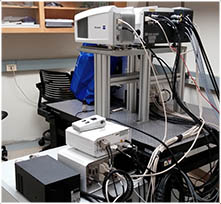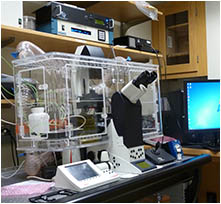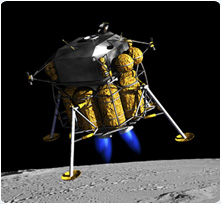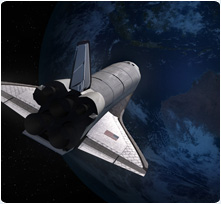Leica STELLARIS 8 FALCON
Inverted laser scanning confocal microscope with multiphoton
(NLO) laser The Leica STELLARIS 8 Spectral confocal microscope
offers maximum flexibility in both choosing an excitation wavelength
and detecting a fluorophore's emission. Our system has 5 Power
HyD detectors, providing high sensitivity across a broad
spectral range. The While
Light Laser (WLL) combined with Leica's proprietary
Acousto-Optical Beam Splitter (AOBS), enables the use of up to 8
simultaneous independent laser lines. The WLL allows you to choose
any excitation wavelength between 440 and 790 nm. When combined with
the Power HyD R detector, you can detect fluorophores in the near
infrared range such as Cy7. The STELLARIS
8 FALCON is an integrated system for fluorescence lifetime
imaging microscopy (FLIM). This is the first instrument in the BIF
with this capability. FLIM measures a photo-physical property of
fluorophores independent from fluorescent intensity that can be used
to improve Förster (Fluorescence) Resonance Energy Transfer (FRET)
experiments. Leica's TauSense uses fluorescence lifetime to provide
a measure of contrast (TauContrast) that is independent from
fluorescent intensity. The TauSense imaging tools include
TauContrast, TauGating which uses differences in average photon
arrival time to remove unwanted background and TauSeparation for
multiplexing using differences in fluorescence lifetime. This
confocal is on a fully motorized Leica DMi 8 inverted microscope.
With the Resonant scanner this microscope can scan images at high
speed, comparable to that of a spinning disc confocal. The LIGHTNING
module allows for super-resolution microscopy. Our Coherent
multiphoton/two-photon laser (MP, a category of nonlinear optics,
NLO) allows for deeper imaging of tissues. The STELLARIS
8 DIVE provides an integrated system for deeper imaging though
our system does not have the 4Tune detectors. The tiling function in
the Leica LAS X software and the motorized stage allows one to
collect multiple images across a large field of view using a high
magnification objective. The black Okolab cage incubator allows for
very light sensitive applications such as two-photon imaging, FLIM
and Fluorescence Correlation Spectroscopy (FCS). The Power HyD X in
Position 4 is the most sensitive detector and is specialized for
FLIM and FCS imaging. The Okolab incubation chamber provides
complete environmental control: Regulating CO2, O2,
humidity and temperature. This microscope was installed March
2021. Location: Beckman Institute Basement Room B131A.
• Inverted microscope has the STELLARIS 8 Scanhead
with 5 Power HyD detectors and 1 detector for transmitted light.
• Two sets of scanning mirrors: standard for
larger frame sizes and 8000K Resonant scanner for high speed
imaging.
• 2 Lasers (1P): 405 DMOD and a pulsed
Supercontinuum White Light Laser (WLL).
• Coherent Chameleon multiphoton (2P) Laser
tunable laser
• Motorized X,Y stage and Z focus.
• Incubation chamber from Okolab regulates CO2,
O2, temperature and humidity.
• AFC (Automatic Focus Control) is Leica's
implementation of auto-focus.
• 5 Power HyD detectors of 3 types in the
following positions: Position 1, HyD S; Position 2, HyD S; Position
3, HyD S SP; Position 4, HyD X; Position 5, HyD R.
Technical Specifications: Scope: Leica DMI
8 inverted microscope.
Laser Lines: 405 nm, Tunable white light laser,
Wavelength Range: 440-790 nm, Total Average Power: ≥ 6 W, Visible
Power: 1200 mW. Tunable 2P Laser 720-1020 nm
OS/Software: Windows 10 Enterprise, LAS (Leica
Application Suite) X
Removable Media: DVD Burner, USB ports,
Network Access.

